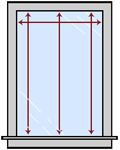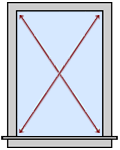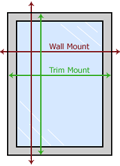Measuring your windows for blinds and shades is easy and we provide these measuring instructions to help make it even easier for you. If you have any questions regarding how to measure properly for our products then please contact us.
Important rules to follow while measuring your windows:
- Always use a steel measuring tape for accuracy.
- Write down WIDTH first then HEIGHT. Do not list them out of order.
- Measure ALL of your windows, even if they appear to be the same size.
- Never measure an existing blind/shade for your measurements.
There are two mount types to consider, Inside Mount and Outside Mount. Please note that mounting onto a door is considered an outside mount.
Inside Mount
|
|
Inside mounted blinds and shades are mounted within the window frame providing a clean, custom look. A great way to leave an attractive window trim exposed.
Please note that if your mounting space is restricted in width or it is between two stationary objects then that is most likely also considered an inside mount because
the inside mount deduction may be required for the product to fit.
|

To properly mount a blind or shade inside the window's frame, your frame must be deep enough to
accommodate the mounting brackets. If the depth of your window's frame is not equal to or greater than the
minimum mounting depth, you will need to measure for an outside mount and mount your product outside the
window frame.

Minimum Inside Mounting Depth is the minimum flat depth required, at the top of the opening, to mount a blind or shade inside the window
opening. This depth allows for the minimum amount of space for the brackets to be mounted. Brackets are top/ceiling mount only. A portion of the blind may protrude
from the window opening.
Flush Inside Mounting Depth is the flat depth required to mount a blind so that it is fully recessed inside the window casing and no
portion of the blind or shade protrudes from the window frame. Obstructions such as window cranks, handles
and other items inside the window opening must be factored into your depth measurement.
|

|
|

|
Width
Measure the exact width of the inside of the window opening, across the TOP only. Write down this measurement. For increments less than 1/8", round down to the nearest
1/8". For example, if the smallest measurement is 36 9/16", round down to 36 1/2". If the smallest measurement is 36 3/8", then do not round down. This is the exact width
you will order. Do not take any deductions from your measurement.
Height
Measure the exact height of the window opening in THREE places: left, middle, right. The height should be measured from the top inside edge of the opening down to the
bottom of the opening, window sill, or floor for patio doors. Take the smallest/shortest of the three measurements (to the nearest 1/8th inch). For increments less than
1/8", round down to the nearest 1/8". For example, if the smallest measurement is 36 9/16", round down to 36 1/2". If the smallest measurement is 36 3/8", then do not round
down. This is the exact height you will order. Do not take any deductions from your measurement.
Important: Do not take any deductions from your measurements. The manufacturing factory will make a 1/2" (+/- 3/16" variance) deduction off the
ordered width and a 1/4" (+/- 3/16" variance) deduction off the ordered height for the proper installation and operation of your blind. Do not increase the measured width to reduce the manufacturer deduction.
|

|
|

|
Measure the window opening on the diagonal from corner to corner. First from the top left corner to the
bottom right corner and then from the top right corner to the bottom left corner. If the two
measurements differ by more than a 1/2" then it is recommended that you switch to an outside mount.
Please note: When measuring, do not be surprised if your windows are not exactly
square, many aren't. If they are a little out of square, it will probably not be noticeable.
|
Outside Mount
|
|
Outside mounted blinds are mounted to the wall or the window trim outside of the window opening and cover
an area larger than the window itself. Provides greater light control and privacy. Perfect
for windows that lack the required depth for an inside mount.
|

|
|

|
Width
Measure the width of the area you wish to cover (left to right). If possible, make sure that the width measurement for the area that you are covering provides at least 3" of
overlap over the actual window opening, 1 1/2" on each side. This will allow for ample coverage, and to ensure maximum light control, over the window opening. If the area
you are measuring does not provide enough overlap over the window opening, then add to the measured width to provide at least 3" of overlap total, 1 1/2" per side, provided
that the mounting space allows for the additional width. This exact width will be your ordered width. No deductions will be taken by the factory. The valance will be
wider than the headrail/track.
Height
Measure the height of the area you wish to cover (top to bottom). It is recommended to allow for at least 3" above the window opening in your height
measurement for mounting the track and valance. You must have the minimum flat mounting surface for proper bracket mounting. In addition to the overlap adjustment
above the window, make sure to provide ample light control overlap below the bottom of the window, as your space allows.
Important:
If the vertical blind extends to the floor (ex. on a sliding patio door) or if it is being mounted over a window
with a window sill that protrudes at the bottom, then deduct 1/4" to 1/2" from the height measurement, so the vertical vanes have proper clearance for operation.
Important:
If you are mounting onto trim that surrounds your window opening, you can measure the exact width and height of the trim, outside edge to outside edge
(make sure the trim provides at least 1 1/2" of coverage overlap per side, beyond the window opening). Provide additional overlap to the width and height
of your measurement if you want to have extra coverage beyond your trim. Your trim must provide the minimum flat mounting surface as stated above.
Important:
Make sure your ordered measurement provides coverage over the entire area that you want to cover and that you
have room for the ordered width and height to fit within your available space.
|

|
|
To preserve your view, you may choose to have your blind or shade stack completely off the window when
it is fully openned. To do this, you will need to add to the outside mount width measurement. Please
refer to the link below for the approximate stacking area based on your ordered draw type:
One Way Draw & Reverse One Way Draw or
Split Draw.
|








